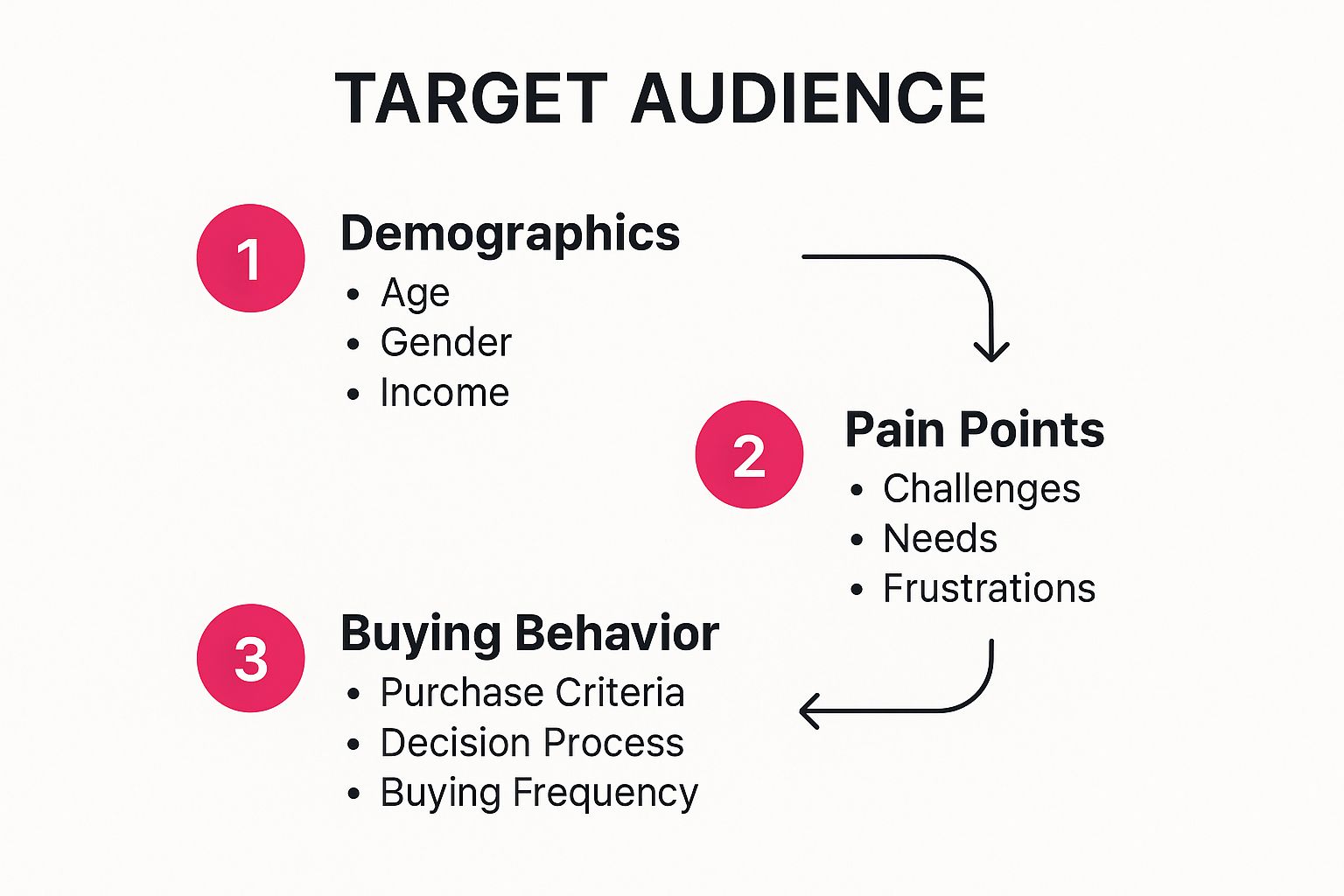Think of a startup marketing plan as a living, breathing guide, not some formal document you write once and forget. It’s the strategic roadmap that keeps your team focused, your spending smart, and your efforts aligned with what actually grows the business. Without one, you're just guessing.
Why a Marketing Plan Is Your Startup’s Roadmap to Growth

Let's be real. Most marketing plans get drafted with a burst of energy, then end up collecting digital dust in a forgotten folder. They become relics of good intentions instead of the day-to-day playbook they're meant to be.
But for a startup, a solid marketing plan is your lifeline.
It’s what prevents you from burning through your seed funding on random ad campaigns or chasing trends that don't connect with your real audience. A well-thought-out plan forces you to be deliberate, turning chaotic brainstorming into a focused strategy for growth.
Turning Ideas Into a Cohesive Strategy
A good startup marketing plan template gives your brilliant ideas a home. It provides the structure to transform a vague thought like, "we should probably be on TikTok," into a measured experiment with clear goals, a budget, and success metrics. It’s the blueprint for how you'll build your brand and attract your first—and next—1,000 customers.
This guide is designed to be practical. We’ll use a downloadable startup marketing plan template to walk through building a plan that’s both strategic and flexible enough to evolve. After all, the best plans aren't set in stone; they adapt as you gather real-world data about your customers and what resonates with them.
“You have to really stay on point for your storytelling—great salespeople are storytellers.” This gets to the heart of it. Your marketing plan is the script for your startup's story, ensuring every ad, email, and social post tells the same compelling tale.
To help you get started, here's a quick look at the essential parts of a marketing plan and why each one is critical for a new business.
Core Components of Your Startup Marketing Plan
| Plan Component | Strategic Purpose | Key Questions to Answer |
|---|---|---|
| Market Analysis | To understand the competitive landscape and find your unique position. | Who are my main competitors? What are their strengths and weaknesses? What market gaps can I fill? |
| Customer Definition | To move beyond vague demographics and truly know who you're selling to. | Who is my ideal customer? What are their pain points? Where do they spend their time online? |
| Channel Strategy | To focus your limited resources on the platforms with the highest impact. | Which 2-3 marketing channels offer the best access to my target audience? How will I approach each one? |
| Smart Budgeting | To allocate funds effectively and justify your marketing spend. | How much can I realistically invest? What is the expected return on each channel? How will I track spending? |
| Meaningful Metrics | To measure what actually matters and track progress toward business goals. | What are the key performance indicators (KPIs) for my startup? How will I measure customer acquisition cost and lifetime value? |
These components form the foundation of a plan that does more than just look good—it drives real results.
Staying Agile in a Fast-Moving Market
In a dynamic market like the UAE, a static plan is a recipe for failure. The Middle East's marketing technology market hit USD 8.29 billion in 2024 and is on a steep growth trajectory. This boom is fueled by incredible internet penetration and strong government pushes for digital transformation.
For any startup here, this means your plan must be built for a digital-first world. Using automation and data-driven tools isn't just a nice-to-have; it's how you'll keep up and carve out your space. You can learn more about this trend from a deep dive into the Middle East's marketing technology landscape on martechafrica.com.
Ultimately, this guide and the template are meant to be your trusted companions. Refer back to them often to make smarter decisions, prove the value of your marketing efforts, and build a lasting foundation for growth.
Moving Beyond Demographics to Find Your Real Customer

Your startup marketing plan template probably has a spot for your target audience. If you've just jotted down something like "millennials in Dubai," I have to be honest: you're setting yourself up to waste a lot of money. That old-school, demographic-first approach is far too broad. It treats your ideal customer like a statistic, not a person.
To get real traction, you have to go deeper. The startups I've seen succeed are the ones that build out a customer persona—a detailed, semi-fictional profile grounded in real data and actual human insights. This isn't just some fluffy creative exercise; it's a strategic tool that will guide every decision you make, from the words you use in an ad to the features you build into your product. This persona becomes your north star, reminding you that you're always talking to a real person with genuine problems.
Blending Data with Human Stories
So, how do you build one of these? A powerful persona is born from a mix of two kinds of information: the hard data you can measure and the human stories you have to go out and find.
You start with the quantitative stuff you likely already have access to. Then, you bring it to life with qualitative insights from real conversations.
- Quantitative Data (The 'What'): This is your starting point. Jump into your Google Analytics and look at the age ranges, locations, and devices people are using. Check your social media insights to see what kind of content they actually engage with. This gives you a solid, fact-based skeleton.
- Qualitative Data (The 'Why'): Here's where the real magic happens. You need to talk to people. Set up short interviews with a handful of potential customers. Ask them open-ended questions about their day, their goals, and what frustrates them about the way things are now. These conversations reveal the why behind the data.
When you put these two together, you stop just knowing what your audience does and start understanding why they do it.
A Real-World FinTech Example
Let's make this tangible. Imagine a FinTech startup in Dubai is building a savings app for young professionals. Their early data shows that most of their website visitors are expats between 25-35 years old. That's a decent start, but it's not nearly enough to build a brand on.
After conducting a few interviews, they uncover the real story. They realize they aren't just talking to "expats." They're talking to "Ambitious Aliyah," a 29-year-old marketing manager who moved from London.
Aliyah is feeling the pressure of Dubai's high cost of living. Her biggest financial goal isn't just to "save money"; it's to save enough for a down payment on a flat back home within five years. Her major pain point? Other banking apps are confusing, clunky, and don't help her visualize progress toward a big, long-term goal. She feels financially "stuck."
This level of detail changes everything. Suddenly, the startup understands its messaging shouldn't be about the generic benefit of "saving money." It needs to be about achieving the dream of homeownership and finally feeling in control of your financial future.
From Persona to Action
Once you have a clear persona like Aliyah, filling out the rest of your startup marketing plan template becomes almost effortless. You can practically see the path forward.
- Channels: Where does Aliyah hang out online? Probably on LinkedIn for her career and Instagram for lifestyle content. Boom—those are now your primary marketing channels.
- Content: What would actually help her? You could create blog posts like "How to Save for a Down Payment While Renting in Dubai" or short, helpful videos explaining investment basics. This is content she'd actively seek out.
- Messaging: Your ad copy can now speak her language. Instead of a bland "Save more with our app," you can hit her pain point directly: "Feeling stuck? See how you can reach your property goals faster."
This deep understanding of one person makes your marketing feel personal and relevant to thousands just like her. It’s the difference between shouting into a crowd and having a meaningful one-on-one conversation. This is the foundation, and everything else in your marketing plan will be built on top of it.
Choosing Marketing Channels That Actually Deliver
Once you have a crystal-clear picture of your customer, the next big question is: where do you actually find them? This part of your startup marketing plan template is critical. With a shoestring budget, you simply can't afford to be everywhere at once. The aim is to sidestep what I call "random acts of marketing" and instead place smart, focused bets on the channels most likely to pay off.
A classic startup blunder is spreading your limited time and money too thin across ten different platforms. It’s a surefire way to get mediocre results on all of them instead of excelling at any. A much savvier move is to pick two or three core channels where your ideal customers genuinely live and breathe, and then go all-in.
This is how you can visualize the process, moving from knowing your customer to picking your playground.

As the graphic shows, understanding who your customer is and what they struggle with leads you directly to their buying habits, which then points you to the right channels.
Weighing Your Options Realistically
Let's cut through the noise and look at some popular channels from a startup's point of view—the real pros and cons, not the textbook ones.
- Performance Marketing (Google & Meta Ads): This is your direct line to immediate results. It's incredibly useful for testing your core message and getting traffic in the door fast. The catch? It can burn through your cash if your unit economics aren't solid. You're essentially renting an audience, and the rent is due every month.
- Content & SEO: Think of this as a long-term investment. By creating genuinely helpful content, you build trust and attract customers organically. It takes months, not days, to see a real return. The initial cost is your time and effort, but the ultimate prize is a sustainable asset that you own outright.
- Community Building (LinkedIn, Niche Forums): This is about creating a home for your customers—a place where they can connect with you and, more importantly, each other. It’s a powerhouse for B2B or passion-driven consumer products but demands authentic, non-salesy engagement. You have to show up and provide value, not just pitch.
After you've acquired customers from these channels, keeping them engaged is the next hurdle. For many, email is the key. Following established email campaign best practices is non-negotiable if you want your messages to land in the inbox and get opened.
A B2B SaaS Startup Scenario
Let’s put this into practice. Imagine you're a B2B SaaS startup selling a new tool to HR managers in the tech industry. Your main persona is "HR Hana." You know from your research that she hangs out on LinkedIn for professional development but turns to Google when she's actively hunting for a software solution to a specific pain point.
You've got a couple of solid options:
- LinkedIn Outreach: You could go straight to Hana with personalized connection requests and messages. This is laser-focused but tough to scale and can quickly feel spammy if you get it wrong.
- Google Ads: You could bid on search terms like "employee onboarding software" to show up the moment Hana is looking to buy. This is scalable but can get expensive fast, especially in a competitive space.
So, what's the smart play? The team decides on a two-pronged attack. They start with Google Ads to capture that immediate, high-intent demand and validate their product's appeal. At the same time, they kick off a "slow-burn" content strategy on LinkedIn, sharing useful articles and insights to build their reputation as industry experts. This approach cleverly balances short-term needs with long-term brand building. For more on this, check out our guide to https://grassrootscreativeagency.com/social-media-marketing-for-startups/.
This strategic channel selection is particularly vital in regions like the UAE, where small and medium-sized enterprises are diving headfirst into digital marketing. The SME segment is growing at about 7% annually, fueling a digital marketing software market expected to hit nearly $1.12 billion in 2024. National initiatives like Saudi's Vision 2030 are only accelerating this shift, compelling startups to master platforms like TikTok and Instagram. This regional context makes choosing the right channels an absolutely critical part of any local startup's marketing plan.
Building a Startup Budget That Isn’t a Guessing Game
https://www.youtube.com/embed/NPqEdQDraho
Let's talk about the part of planning that often ties founders in knots: the budget. So many startups just pull a number out of thin air, cross their fingers, and hope for the best. But a good budget isn't a guessing game or a rigid spreadsheet you're afraid to touch. It's about making smart, agile bets on your growth.
The first step is a mental one. Stop thinking of marketing as a cost. It’s an investment. Every single dollar should have a job to do, whether that’s bringing in a lead today or building brand equity that pays off for years to come. Once you make that shift, you're on the right track to creating a budget that actually works.
Practical Budgeting Models for Startups
Forget the labyrinthine financial models you see at big corporations. As a startup, you need something simple and flexible. The percentage-of-revenue model is a great starting point, but you have to adapt it. If you're not generating revenue yet, you can simply base your percentage on your total operating capital instead.
A common rule of thumb is to set aside 5-10% of revenue (or capital) for marketing. But please, don't treat that as gospel. A B2B SaaS company might lean heavily into content and SEO early on, while a new e-commerce store will likely pour cash into performance ads to get those initial sales.
The real key is to get granular inside your startup marketing plan template. Don't just lump everything under one big "marketing" line item. Break it down.
- Tools & Technology: Your CRM, analytics software like Google Analytics, and social media schedulers.
- Content Creation: What you'll pay freelance writers, designers, or video editors.
- Paid Advertising: Your budget for platforms like Google Ads and Meta.
- Personnel: If you've hired a marketing person, their salary belongs here.
A well-structured budget provides clarity. It transforms your marketing from a vague "expense" into a portfolio of targeted investments, each with an expected return. This is how you justify spending and make informed decisions about what to scale up or cut back.
Real-World Budget Allocation Scenario
Let's make this real. Imagine a new e-commerce startup here in Dubai. They have a modest marketing budget of AED 10,000 per month and need to balance getting sales now with building a foundation for the future.
Here’s one way they could slice the pie:
- Performance Ads (AED 6,000): The biggest chunk goes straight to Meta and Google Ads. The goal here is immediate traffic and sales. This also gives them quick feedback on which products and messages are hitting the mark.
- Content & SEO (AED 3,000): They decide to hire a freelance writer to create two quality blog posts per month targeting specific long-tail keywords. This is the long game—building an organic traffic engine that won't cost them per click.
- Marketing Tools (AED 1,000): This covers essentials like their email marketing platform and maybe some basic analytics or design software.
This is a smart mix of short-term wins and long-term asset building. For a more detailed breakdown of this thinking, our guide on creating a marketing budget for a small business has more frameworks you can steal.
This kind of strategic thinking is absolutely vital in the UAE. Startups are competing in a market where massive enterprises control about 62% of the advertising agency market share, according to a report from Mordor Intelligence. They set a high bar with huge campaigns on major platforms.
You can't outspend them. So, your startup marketing plan has to outsmart them. That means your budget must reflect a laser-focus on niche targeting, cost-effective digital tactics, and the agility to double down on what works. Prioritizing ROI isn't just a good idea—it's how you survive and thrive.
Tracking Metrics That Actually Matter for Growth

Let's be honest: a plan is just a document until you can prove it's working. Once you’ve launched your startup marketing efforts, you need to know what’s actually moving the needle and what's just burning through your cash. It’s time to look past the "vanity metrics" that feel good—like social media likes—and zero in on the numbers that tell the real story of your business's health.
The trick is to watch both sides of the coin. Leading indicators, like a jump in website traffic or new email subscribers, give you a glimpse into future success. Then you have lagging indicators, like your Customer Acquisition Cost (CAC) and Lifetime Value (LTV), which show you the final outcome of your past activities. A smart startup keeps a close eye on both.
Defining Your Key Performance Indicators
Your Key Performance Indicators (KPIs) are the few, crucial metrics that directly reflect your business goals. Don't fall into the trap of tracking everything.
- If your main goal is brand awareness, you'll want to watch organic search impressions or social media reach.
- If it's all about lead generation, you’ll be obsessed with the number of qualified leads coming from each channel.
Every KPI you choose should be tied to a clear, actionable goal. For instance, instead of just "improve ads," a solid goal is to "reduce CAC by 15% in Q3 by refining our Google Ads audience targeting." If you need some ideas, you can explore a great list of different marketing performance indicators to get started.
Your marketing dashboard should tell a clear story. If a metric doesn't help you decide where to invest your next dollar or hour, it's not a KPI—it's just noise.
Mapping Marketing Goals to Key Performance Indicators (KPIs)
To make this practical, it helps to connect your big-picture business objectives to the exact metrics that measure them. This framework ensures every marketing action you take is accountable and driven by real data.
This simple table can help you translate your goals into a tangible tracking plan.
| Business Goal | Primary KPI | Secondary Metrics | Tracking Tool |
|---|---|---|---|
| Increase Brand Awareness | Organic Search Traffic | Social Media Reach, Branded Search Volume | Google Analytics, Social Media Insights |
| Generate Qualified Leads | Marketing Qualified Leads (MQLs) | Cost Per Lead (CPL), Form Conversion Rate | CRM, HubSpot, Google Analytics |
| Drive Initial Sales | Customer Acquisition Cost (CAC) | Conversion Rate, Average Order Value (AOV) | E-commerce Platform, CRM |
| Improve Customer Retention | Customer Lifetime Value (LTV) | Churn Rate, Repeat Purchase Rate | Stripe, CRM, E-commerce Platform |
Using a structure like this turns your startup marketing plan template from a document of good intentions into a dynamic tool for growth. It gives you a clear lens to see what's working so you can confidently double down on your best-performing channels.
Remember, tracking the numbers is only half the battle. True growth comes from understanding how those numbers fit together. Exploring sales funnel optimization strategies is a critical next step. It helps ensure you're not just attracting traffic, but effectively turning those visitors into paying, loyal customers.
Answering Your Top Questions
Even with the best template in hand, you're bound to have questions. It's only natural. Let's walk through some of the most common ones I hear from founders so you can move forward with total confidence.
How Often Should I Actually Look at This Thing?
Your marketing plan isn't a one-and-done document you frame on the wall. Think of it as a living, breathing guide.
For most early-stage startups, a quarterly review hits the sweet spot. This cadence is frequent enough to let you respond to real data and market shifts, but not so often that you're constantly changing direction and getting whiplash.
The exception? If you've just launched or are fighting for air in a super-crowded market, a monthly check-in is a smart move. It keeps you nimble and allows you to double down on what’s working right now.
What's the Single Biggest Mistake Founders Make with Their Marketing Plan?
It’s surprisingly simple: they create a brilliant, in-depth plan and then… it just sits there, gathering digital dust in a forgotten Google Drive folder. A plan is completely useless if it doesn't guide your actual day-to-day work. Execution is the only thing that matters.
The other classic mistake I see all the time is a total lack of focus. Founders get excited and try to be everywhere at once—every social channel, every type of ad, every content format. This is a fast track to burning through your cash and energy with nothing but mediocre results to show for it. A great startup marketing plan template forces you to be ruthless with your priorities.
Can I Really Do This with a Zero-Dollar Budget?
Yes, you absolutely can. But let's be clear: "free" doesn't mean no cost. The investment just shifts from money to your time, energy, and creativity—what many call "sweat equity." A zero-budget plan simply means you're going all-in on organic growth.
Your plan won't have a section for paid ads, but it will be just as rigorous. You'll map out your specific activities, set deadlines, and define what success looks like. The focus typically lands on a few key areas:
- Content Creation: Forget fluff. Write genuinely useful blog posts that solve your ideal customer's most pressing problems.
- SEO Basics: Learn the fundamentals of on-page and technical SEO. If people can't find your brilliant content on Google, it doesn't exist.
- Community Building: Show up where your audience hangs out, whether that's LinkedIn, a niche subreddit, or a specific forum. Engage, don't just broadcast.
- Personal Networking: Tap into your own network. You'd be amazed at how much initial traction you can get from old colleagues, friends, and industry contacts.
This path requires a ton of patience and grit, but it's how countless successful companies built an incredibly strong foundation before ever spending a dirham on ads.
Ready to stop guessing and start growing? The Grassroots Creative Agency team specializes in transforming ideas into data-driven marketing plans that deliver real results. We build strategies that are as bold and unique as your startup. Let's build your roadmap to success together.








